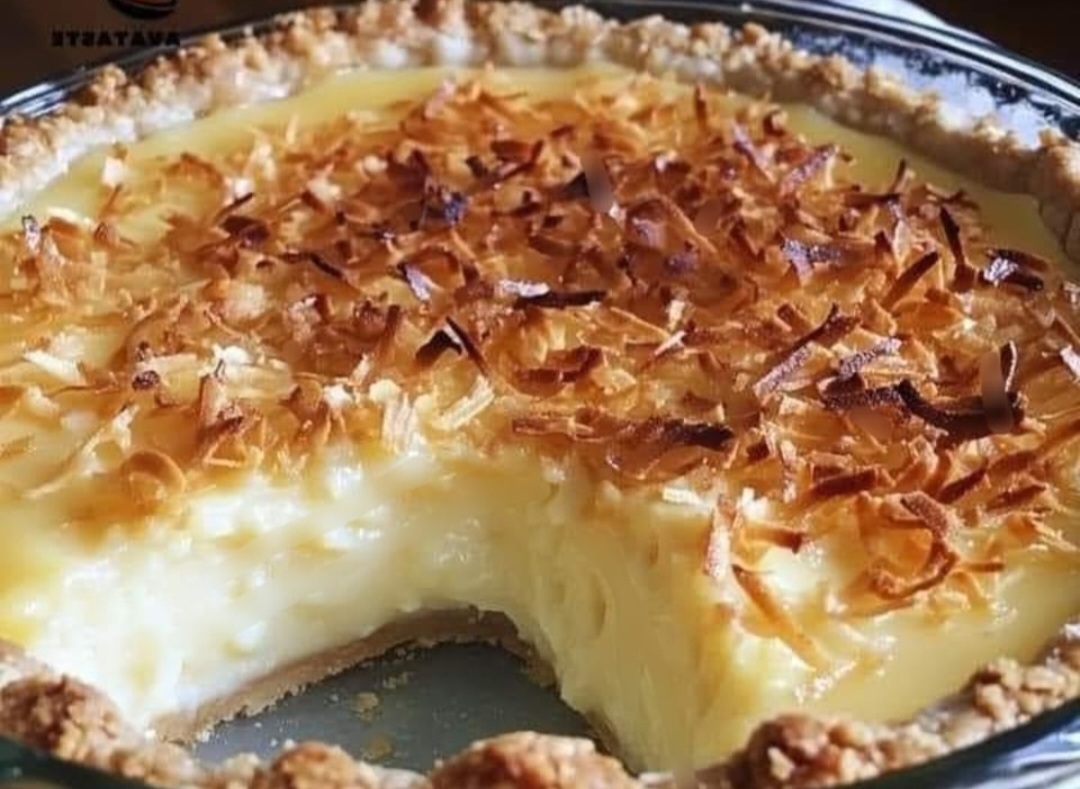Coconut Custard Pie
Indulge in the creamy, tropical flavors of this Coconut Custard Pie!
Perfectly baked with a golden top, this dessert is sure to delight anyone with a sweet tooth.
Ingredients:
2 cups milk
1 cup shredded coconut
4 eggs
1 teaspoon vanilla extract
1/2 cup all-purpose flour
7 tablespoons butter, melted
3/4 cup sugar
1/4 teaspoon ground nutmeg
Extra coconut for topping (optional)
Directions:
Preheat Oven: Preheat your oven to 350°F (175°C).
Mix Ingredients:
In a large mixing bowl, combine the milk, shredded coconut, eggs, vanilla extract, flour, melted butter, and sugar.
Blend well until the mixture is smooth.
Prepare Pie Pan: Pour the mixture into a buttered and floured pie pan.
Add Toppings:
Sprinkle the top with ground nutmeg and additional shredded coconut if desired.
Bake: Place in the preheated oven and bake for 45 minutes, or until the pie is set and the top is golden brown.
Cool and Refrigerate:
Remove from the oven and let it cool at room temperature. Once cooled, refrigerate until nice and cold.
Recipe Details
Prep Time: 15 minutes
Cooking Time: 45 minutes
Total Time: 1 hour
Servings: 8 servings
Here are some variations and tips to help you elevate your Coconut Custard Pie:
Variations:
Coconut Cream Pie Twist: Instead of using only milk, incorporate some coconut milk or coconut cream to intensify the coconut flavor and create a creamier texture.
Toasted Coconut Topping: Sprinkle toasted coconut flakes on top of the pie before or after baking to add a crunchy texture and enhance the coconut flavor.
Chocolate Coconut Custard Pie: Add a layer of melted chocolate or chocolate ganache on the bottom of the pie crust before pouring in the custard mixture for a chocolatey twist.
Citrus Zest: Add a teaspoon of lemon or lime zest to the custard filling for a bright, tangy contrast to the rich coconut flavor.
Spiced Coconut Custard Pie: Mix in a pinch of cinnamon, nutmeg, or cardamom into the custard for a warm and aromatic variation.
Graham Cracker Crust: Instead of the traditional pastry crust, use a graham cracker or cookie crumb crust to add a crunchy, sweet layer that pairs beautifully with the coconut filling.
Nut Crust: For a twist, use a crust made from crushed macadamia nuts or almonds to complement the tropical coconut flavor.
Tips:
Use Full-Fat Dairy: For a rich and creamy custard, use full-fat milk, cream, or coconut milk. Low-fat versions may result in a thinner, less creamy custard.
Blind Bake the Crust: To avoid a soggy bottom, blind bake the pie crust before adding the custard filling. This ensures a crisp, golden crust.
Custard Consistency: When baking, be careful not to overbake the custard. It should be set but still slightly wobbly in the center when you take it out of the oven, as it will continue to set while cooling.
Eggs at Room Temperature: Bring eggs to room temperature before mixing. This helps them blend more smoothly into the custard, creating a better texture.
Prevent Cracks: Bake the pie in a water bath (place the pie dish in a larger pan filled with hot water) to prevent the custard from cracking.
Chill Before Serving: Coconut custard pie is best served cold. After baking, let the pie cool completely and refrigerate it for at least a few hours, preferably overnight, to allow the flavors to develop.
Extra Coconut Flavor: For an extra boost of coconut flavor, add a teaspoon of coconut extract to the custard mixture.
These variations and tips will help you personalize your coconut custard pie and ensure it turns out perfectly every time!
To store Coconut Custard Pie and maintain its flavor and texture, follow these steps:
Refrigeration (Short-Term Storage)
Duration: Up to 3-4 days
Coconut custard pie should always be refrigerated due to its dairy and egg content.
Once the pie has cooled completely after baking, cover it tightly with plastic wrap or aluminum foil and place it in the refrigerator.
You can also store individual slices in an airtight container for easier access.
Freezing (Long-Term Storage)
Duration: Up to 2 months
Freezing the Whole Pie: Let the pie cool completely. Wrap the pie tightly in plastic wrap, then cover with aluminum foil to prevent freezer burn.
Freezing Slices: You can freeze individual slices by wrapping each one in plastic wrap and placing them in a freezer-safe container or bag.
Thawing: To thaw, move the pie from the freezer to the refrigerator and let it thaw overnight. Avoid thawing at room temperature, as this may affect the texture of the custard.
Reheating (Optional): If you’d like to serve the pie warm, reheat it in the oven at 325°F (160°C) for about 10 minutes after thawing.
Additional Tips:
Avoid Direct Wrapping: When wrapping the pie, try not to let the plastic wrap touch the custard surface, as this may disturb its texture when removed.
Refrigerate Promptly: For food safety, don’t leave the pie at room temperature for more than 2 hours after baking or serving. Always refrigerate it promptly.
By following these methods, you can keep your coconut custard pie fresh and delicious for several days!
